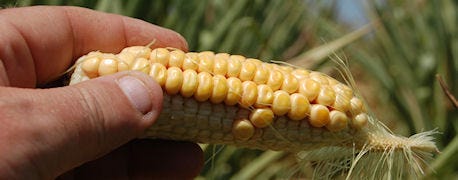
If every ear on every stalk in every field you farm has 18 rows with 40 kernels per row and 30,000 or more plants per acre, congratulations. You can just file this item for another year, or hopefully, another lifetime- like never again! However, the next time it’s dry and hot, you may not be so fortunate.

Flagship for 2012- Unfortunately this ear could become the signature ear for the season.
If you only have 20,000 ears and planted 30,000 or more, and some don’t look so good, or if you planted 30,000 and can’t find any ears in spots, don’t feel alone. You have plenty of company. The best way to explain why you’re seeing what you’re seeing is to note that in Indiana at least, we’ve compiled weather data of the supposedly worst years this century for growing corn. The 2012 season rivals 1936, and is worse than 1934, 1988, 1983, 1950 and 1991 in all but extreme north-central Indiana near the Michigan border, and that’s just because they’ve received some lake effect rains lately.
Common are ears with only a few kernels. Bob Nielsen, Purdue University Extension corn specialist, says that if the silks are still there and attached, the ear likely didn’t pollinate. If the silks aren’t there, it likely pollinated but then the plant decided to abort the kernels. Remember the plant has one goal- to produce as many viable progeny as possible. Something within the plant tells it if it doesn’t think it can fulfill what it has started, it makes adjustments—sometimes extreme adjustments.
If ears are filled out but a bit short, with an inch or more of bare cob at the end, and no silks are attached to the end of the cob, then those kernels likely were fertilized, but aborted. That’s the most common sight in normal drier years, because tip kernels are fertilized last, and would be the first to be aborted if the plant decided it needed to cut back.
You may find many barren plants. Some may have no evidence of ear shoots. In the worst situations, plants simply never put out a shoot. In other cases they may have put out a shoot, and there may be a small ear or partial ear, with barren stalks around it. It’s likely in these cases that the shoot didn’t come out until after the pollen was gone.
Although it’s unusual, it’s possible it was so hot that some of the pollen itself was actually damaged by the heat, Nielsen says. Problems with tassels aren’t usually a problem, but this is a benchmark year, not a normal year- the worst year in 75 years in many places, by all indications so far.
About the Author(s)
You May Also Like




